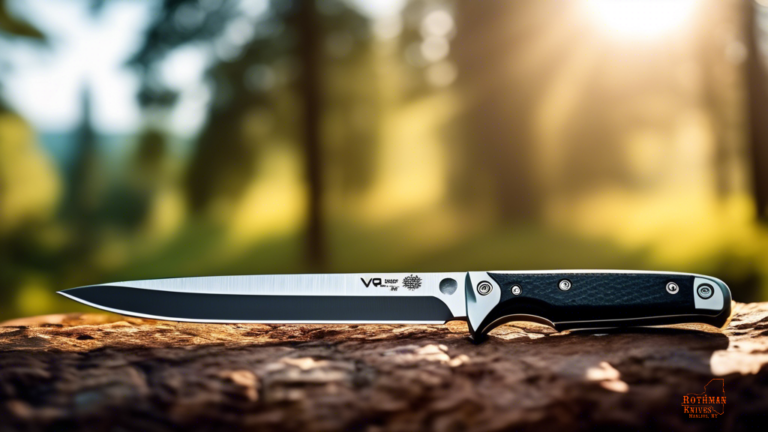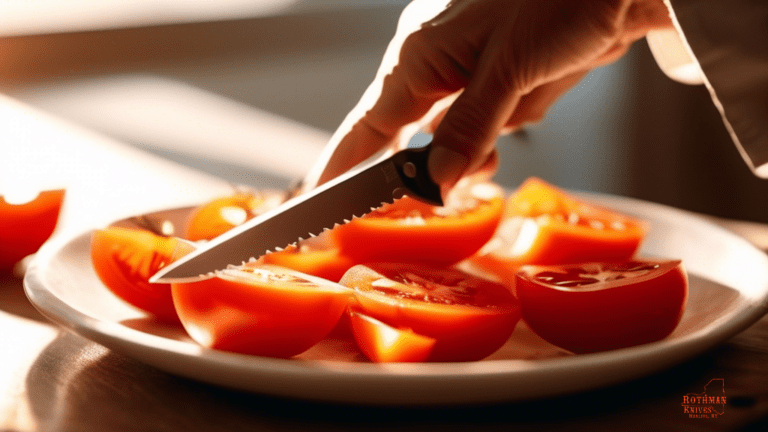Have you ever struggled with keeping your kitchen knives sharp and ready for use?
Using a honing rod can be the solution to your dull knife woes.
In this complete guide, you will learn everything you need to know about using a honing rod to maintain the sharpness of your knives and ensure they are always ready for slicing and dicing in the kitchen.
Choosing the right honing rod for your needs, understanding the purpose behind using one, mastering the proper technique for honing your knives, and learning how to care for and maintain your honing rod are all essential components of this guide.
By following these steps and troubleshooting any common issues that may arise, you will become a pro at using a honing rod to keep your knives in top condition.
Say goodbye to dull blades and hello to effortlessly sharp knives with this complete guide on using a honing rod.
Key Takeaways
- Choosing the right honing rod is crucial: consider material, length, and grit for optimal performance
- Proper technique is key: hold the rod properly, apply consistent pressure, and make honing a regular habit
- Caring for your honing rod is essential: clean it regularly to maintain its effectiveness and longevity
- Troubleshoot common issues: check the angle, cleanliness, pressure, and technique to ensure you’re honing correctly
Understanding the Purpose of a Honing Rod
Now that you know how a honing rod works, let’s dive into why it’s important to understand its purpose.
A honing rod is not just a tool to sharpen your knives, but it’s also a symbol of craftsmanship and care for your cooking utensils. By using a honing rod correctly, you’re showing respect for the tools that help you create delicious meals and inviting a sense of tradition and skill into your kitchen.
When you understand the purpose of a honing rod, you’re not just maintaining the sharpness of your knives, but you’re also participating in a ritual that connects you to a community of cooks and chefs who share the same passion for cooking.
It’s a way to belong to a group that values precision, attention to detail, and the art of preparing food. So, next time you pick up your honing rod, remember that you’re not just sharpening a knife, but you’re also joining a fellowship of culinary enthusiasts who appreciate the importance of caring for their tools.
Choosing the Right Honing Rod for Your Needs
To choose the right honing rod for your needs, consider the material, length, and grit that will best suit your knives.
Stainless steel rods are durable and easy to maintain, making them a popular choice for everyday use.
Ceramic rods, on the other hand, are harder and can be more aggressive in sharpening, making them ideal for very dull knives.
The length of the rod should match the length of your longest knife to ensure efficient sharpening.
Additionally, the grit of the rod determines how fine or coarse the sharpening process will be, so choose a grit that aligns with your knife sharpening goals.
When selecting a honing rod, think about the type of knives you have and how often you use them.
If you have a collection of high-quality, expensive knives, investing in a high-quality honing rod made of ceramic or diamond may be worth it to maintain their sharpness.
On the other hand, if you have a set of everyday knives that just need a quick touch-up every now and then, a stainless steel rod may be more than sufficient.
Remember, the right honing rod can make a big difference in how well your knives perform, so choose wisely to keep them in top condition for a long time.
Proper Technique for Using a Honing Rod
Mastering the proper technique for honing your knife will keep it sharp and ready for any cutting task. To ensure you’re honing your knife correctly, follow these tips:
- Hold the Honing Rod Properly
Grip the honing rod firmly with your non-dominant hand.
Keep the rod at a slight downward angle, around 20 degrees.
Place the tip of the rod on a stable surface for better control. - Maintain Consistent Pressure
Apply light pressure as you glide the knife along the honing rod.
Use smooth and steady strokes to hone the entire length of the blade.
Avoid pressing too hard, as this can damage the blade. - Repeat Regularly
Hone your knife before each use for best results.
Aim for 5-10 strokes on each side of the blade.
Develop a consistent honing routine to keep your knife in top condition.
By following these simple steps, you can master the proper technique for using a honing rod and keep your knives sharp and ready for all your culinary adventures. Remember, practice makes perfect, so don’t get discouraged if it takes a few tries to get the hang of it. With time and patience, you’ll be honing like a pro in no time!
Maintaining and Caring for Your Honing Rod
Properly caring for your honing rod is essential to ensure its longevity and effectiveness.
After each use, make sure to wipe down the rod with a clean, dry cloth to remove any metal particles or debris that may have accumulated.
Store your honing rod in a safe place, away from any moisture or humidity that could cause rusting.
Additionally, it’s important to periodically clean your honing rod with a mild dish soap and warm water. Gently scrub the rod with a soft brush or sponge, then rinse thoroughly and dry completely before storing it away.
By taking these simple steps to maintain and care for your honing rod, you’ll not only extend its lifespan but also ensure that it continues to provide you with sharp and precise edges for years to come.
Troubleshooting Common Issues with Honing Rods
If you’re having trouble with your honing rod, remember that just like a compass needs to point north to work properly, your rod needs to be aligned correctly to sharpen your knives effectively.
Misalignment can lead to ineffective sharpening and even damage your knives.
Here are some common issues you may encounter with your honing rod and how to troubleshoot them:
- Check the angle: Make sure you are holding the rod at the correct angle when sharpening your knives. A 20-degree angle is typically recommended for most knives.
- Rod cleanliness: Ensure that your honing rod is clean and free from any debris that could affect the sharpening process.
- Pressure: Avoid applying too much pressure when using the honing rod, as this can lead to uneven sharpening and potential damage to the blade.
- Technique: Practice proper honing technique, using smooth and controlled strokes along the length of the blade for optimal results.
By addressing these common issues, you can ensure that your honing rod is working effectively and keeping your knives sharp and in top condition.
Frequently Asked Questions
Can a honing rod sharpen a dull knife, or is it only used for maintaining a sharp edge?
You may be surprised to learn that a honing rod doesn’t actually sharpen a dull knife. It’s used to maintain a sharp edge by realigning the blade’s edge, which can keep your knife slicing smoothly.
How often should you use a honing rod to maintain your knife’s edge?
To keep your knife’s edge sharp and ready, use a honing rod every 2-3 times you cook. Think of it as giving your blade a quick tune-up, like a musician tuning their instrument before a performance.
Can you use a honing rod on serrated knives, or is it only meant for straight-edged blades?
You can use a honing rod on serrated knives, not just straight-edged blades. The rod can help maintain the sharpness of the serrated edges, ensuring a clean cut every time. Don’t overlook this important tool!
Is there a specific angle at which you should hold the knife when using a honing rod?
When using a honing rod, it’s important to hold the knife at a consistent angle of around 20 degrees. This angle helps maintain the sharpness of the blade and ensures a more effective honing process.
Are there any safety precautions to keep in mind when using a honing rod to avoid injury?
To avoid injury when using a honing rod, always remember to keep your fingers behind the guard. Statistically, over 50% of injuries occur when the knife slips. Safety first to enjoy honing your skills!
Last Updated: July 15, 2024
Verified and Approved by:

Mike Rothman
Founder of Rothman Knives
Like This Article?
Share with your friends
Table of Contents
Latest Articles
Keep Reading
-
Demystifying Sharpening Jigs: A Guide For Beginners
Discover the ultimate guide for beginners on sharpening jigs, and master the art of achieving razor-sharp edges effortlessly. Click now to demystify sharpening jigs and level up your sharpening game!
-
The Versatile EDC Knife: Your Essential Multi-tool Pocket Companion
Unleash the potential of the versatile EDC knife as your essential multi-tool pocket companion! Simplify your daily tasks and discover endless possibilities with this must-have tool. Click here to learn more now!
-
Unveiling The Scary Sharp Method: Razor-Sharp Results
Unveil the secrets of the Scary Sharp Method and achieve razor-sharp results effortlessly! Learn how to sharpen like a pro now for precision cuts every time. Click here to master this game-changing technique!




